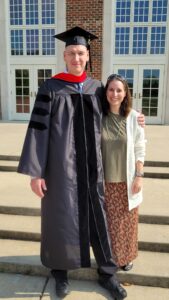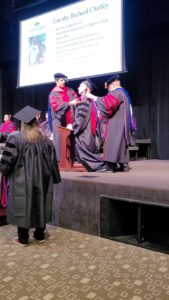
Getting a photo with my lovely bride prior to the graduation ceremony. Notice that she’s standing on a higher step to slightly make up for the height difference.
Dr. Tim Chaffey—yeah, it still sounds weird. On May 21, I graduated from Shepherds Theological Seminary in Cary, North Carolina after earning a Doctor of Ministry, specializing in advanced biblical and theological studies. This is the main reason I have written so few blog posts over the past couple of years—I’ve been too busy with my classes. I plan to post numerous articles in the coming months that will be adapted from some of my assignments.
Completing a doctorate has been a long journey. I originally enrolled in the Ph.D. in Apologetics and Theology at Liberty in 2008. After a year of courses, I switched programs and earned a Th.M. instead. The main reason for this was the time commitment. I was spending about 20–25 hours a week on school and working full-time while my kids were still relatively young. I realized that I would not have finished the program until my daughter had finished high school and my son would have been in junior high. I decided that I wouldn’t even consider working on a doctorate until my son finished high school. Spending time with the kids was too important, so I left that program even though I really enjoyed it…well, most of it. I’ll be happy if I never crack open another book by or about Augustine of Hippo (5,000 pages of reading and writing 50 pages for one class was more than enough for me).
Shortly before my son finished high school, I had an opportunity to give a tour of the Ark Encounter to some students and staff from Shepherds. When I checked out the school’s doctrinal statement and saw that one of the doctoral areas of specialization was advanced biblical and theological studies, I became very interested. Within a year, I had enrolled in classes, and last week I became part of the first class of doctoral graduates at Shepherds.
I truly enjoyed my classes and my dissertation fit perfectly with the next big project the design team is working on for the Ark Encounter. We are building the world’s most accurate model of first century Jerusalem. The massive model at Israel Museum in Jerusalem is built on a 1:50 scale (1 foot = 50 feet), and our model will be half that scale (1:100). While that model is amazing, ours will far surpass it in terms of accuracy and realism. The Israel Museum model is rather plain in that it only depicts the buildings and walls, and nearly everything is made out of the same stones. Also, that model was made in the 1960s, prior to many of the archaeological excavations in the city. Our model will reflect the latest research, and we plan to populate our model with 15,000–20,000 miniature 3D-printed people as well as thousands of animals, trees, and other objects that would be seen in a city. We plan to enhance the experience with dozens of interactive displays filled with biblical, historical, and archaeological teaching.

The hooding ceremony with Dr. Pete Goeman (left) and Dr. Dave Burggraff (right).
Since I will be responsible for developing the teaching content that will be associated with the model, I wanted to write my dissertation on a subject that would relate to the project. My paper is titled “A Historical Study of Jerusalem c. AD 33 and Its Implications on Creating an Accurate Scale Model to Enable Believers to Gain a Deeper Understanding of the New Testament.” After highlighting the importance of biblical geography to hermeneutics, I spent the bulk of the paper contrasting first-century Jerusalem to today’s “Old City.” This necessarily included an examination of numerous misnamed/misplaced sites that tourists are typically shown while touring Jerusalem as well as critiques of a couple conspiracy theories related to the temple and Temple Mount. Finally, one chapter describes the work that has already gone into designing and building our model.
Since completing the dissertation, I have been writing a book to address the conspiracy theories related to the temple and Temple Mount. Over the past few decades, some individuals have promoted the idea that Solomon’s and Herod’s temples were located in the City of David rather than on the Temple Mount. Known as the Alternate Location Theory (ALT) and popularized by Ernest L. Martin and Robert Cornuke, the theory is demonstrably false and its proponents ignore archaeological findings and regularly misuse historical sources, such as the Bible and the writings of Josephus. Since much of the research was conducted while writing my dissertation, it should not take too long to write, and I hope it will be available within a few months. I’ll share more details about this project in upcoming posts.

Dr. Chaffey, I will be looing into your writings. Yout background and studies intrugue me. I appreciate how you did not neglect your family, and God blessed your pursuit of Him.
Congrats, Tim!